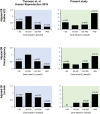Do early luteal serum progesterone levels predict the reproductive outcomes in IVF with oral dydrogesterone for luteal phase support?
- PMID: 31361764
- PMCID: PMC6667136
- DOI: 10.1371/journal.pone.0220450
Do early luteal serum progesterone levels predict the reproductive outcomes in IVF with oral dydrogesterone for luteal phase support?
Abstract
Objective: We sought to determine whether the early luteal serum progesterone (P4) level predicts the success of IVF treatment with oral dydrogesterone for luteal support.
Method: This retrospective monocentric cohort study included 242 women who underwent IVF treatment with fresh embryo transfer (ET) between July 2017 and June 2018. The population was unselected, and women were treated according to our unit's usual stimulation protocols. For the luteal phase support (LPS), all women were supplemented with a 10 mg three-times-daily dose of oral dydrogesterone beginning on the day of oocyte pick-up (OPU). Blood sampling was performed on the day of ET (Day 2-3 after OPU) to determine the early luteal serum progesterone level.
Results: ROC curve analysis allowed us to determine two thresholds for the prediction of live birth using the early P4 level. Women who had early luteal P4 levels greater than 252 nmol/l had a significantly higher live birth rate (27.1%) than women with early luteal P4 between 115 and 252 nmol/l (17.2%) and women with early luteal P4 below 115 nmol/l (6.0%; p = 0.011). After a multiple regression analysis, an early luteal P4 level greater than 252 nmol/l was still associated with a higher chance of a live birth than a P4 between 115 and 252 nmol/l (OR = 0.40 [0.18-0.91]; p = 0.028) or a P4 below 115 nmol/l (OR = 0.10 [0.01-0.52]; p = 0.006).
Conclusions: Our study suggests a positive association between early P4 levels and reproductive outcomes in IVF using oral dydrogesterone for luteal support. The inconsistencies between our results and those of other studies suggest that extrapolation is impractical. Further larger prospective cohort studies should be conducted to determine reliable thresholds that could be used to personalize luteal phase support.
Conflict of interest statement
The authors have declared that no competing interests exist.
Figures


Similar articles
-
The impact of luteal serum progesterone levels on live birth rates-a prospective study of 602 IVF/ICSI cycles.Hum Reprod. 2018 Aug 1;33(8):1506-1516. doi: 10.1093/humrep/dey226. Hum Reprod. 2018. PMID: 29955789
-
A Phase III randomized controlled trial comparing the efficacy, safety and tolerability of oral dydrogesterone versus micronized vaginal progesterone for luteal support in in vitro fertilization.Hum Reprod. 2017 May 1;32(5):1019-1027. doi: 10.1093/humrep/dex023. Hum Reprod. 2017. PMID: 28333318 Free PMC article. Clinical Trial.
-
Oral dydrogesterone versus intravaginal micronized progesterone gel for luteal phase support in IVF: a randomized clinical trial.Hum Reprod. 2018 Dec 1;33(12):2212-2221. doi: 10.1093/humrep/dey306. Hum Reprod. 2018. PMID: 30304457 Free PMC article. Clinical Trial.
-
Dydrogesterone as an oral alternative to vaginal progesterone for IVF luteal phase support: A systematic review and individual participant data meta-analysis.PLoS One. 2020 Nov 4;15(11):e0241044. doi: 10.1371/journal.pone.0241044. eCollection 2020. PLoS One. 2020. PMID: 33147288 Free PMC article.
-
Oral dydrogesterone for luteal phase support in fresh in vitro fertilization cycles: a new standard?Fertil Steril. 2018 May;109(5):756-762. doi: 10.1016/j.fertnstert.2018.03.034. Fertil Steril. 2018. PMID: 29778368 Review.
Cited by
-
Luteal phase support in assisted reproductive technology.Nat Rev Endocrinol. 2024 Mar;20(3):149-167. doi: 10.1038/s41574-023-00921-5. Epub 2023 Dec 18. Nat Rev Endocrinol. 2024. PMID: 38110672 Review.
-
Progesterone level in assisted reproductive technology: a systematic review and meta-analysis.Sci Rep. 2024 Dec 28;14(1):30826. doi: 10.1038/s41598-024-81539-z. Sci Rep. 2024. PMID: 39730597 Free PMC article.
-
Regulatory T cells are paramount effectors in progesterone regulation of embryo implantation and fetal growth.JCI Insight. 2023 Jun 8;8(11):e162995. doi: 10.1172/jci.insight.162995. JCI Insight. 2023. PMID: 37191999 Free PMC article.
-
Systematic use of long-acting intramuscular progesterone in addition to oral dydrogesterone as luteal phase support for single fresh blastocyst transfer: A pilot study.Front Endocrinol (Lausanne). 2022 Dec 23;13:1039579. doi: 10.3389/fendo.2022.1039579. eCollection 2022. Front Endocrinol (Lausanne). 2022. PMID: 36619564 Free PMC article.
-
Role of Dydrogesterone for Luteal Phase Support in Assisted Reproduction.Reprod Sci. 2024 Jan;31(1):17-29. doi: 10.1007/s43032-023-01302-z. Epub 2023 Jul 24. Reprod Sci. 2024. PMID: 37488405 Review.
References
-
- Fauser BC, de Jong D, Olivennes F, Wramsby H, Tay C, Itskovitz-Eldor J, et al. Endocrine profiles after triggering of final oocyte maturation with GnRH agonist after cotreatment with the GnRH antagonist ganirelix during ovarian hyperstimulation for in vitro fertilization. J Clin Endocrinol Metab. 2002;87: 709–715. 10.1210/jcem.87.2.8197 - DOI - PubMed
MeSH terms
Substances
Associated data
LinkOut - more resources
Full Text Sources

